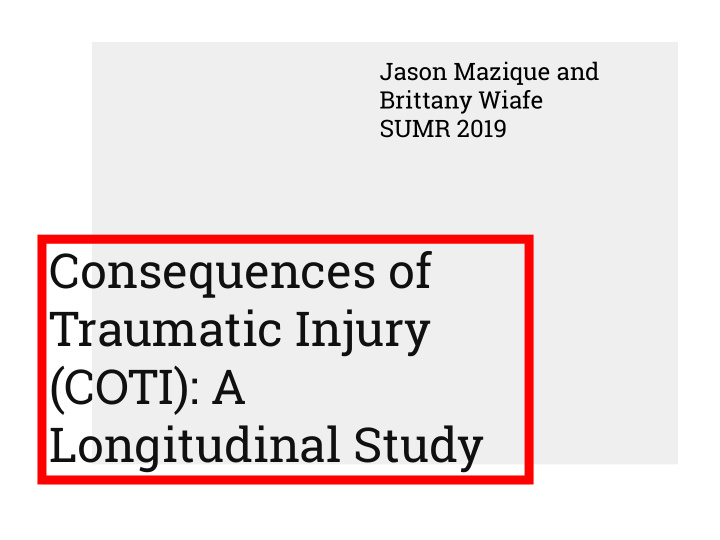



Jason Mazique and Brittany Wiafe SUMR 2019 Consequences of Traumatic Injury (COTI): A Longitudinal Study
Project Overview Prospective quantitative longitudinal study of factors that cause racial and ethnic pain disparities Looks at the transition from acute to chronic pain after a traumatic physical injury Short term objective Identify intervention targets for reducing/ eliminating racial and ethnic pain disparities. Long term objective Contribute to the reduction and elimination of racial and ethnic pain disparities. 2
Traumatic Injury → Traumatic Injury : physical injuries of sudden onset and severity which require immediate medical attention → Trauma is the #1 cause of death for people under 44 → Black and Hispanic patients were found to have 20% to 50% greater likelihoods of death respectively due to traumatic injuries https://www.cdc.gov/injury/wisqars/pdf/10lcid_all_deaths_by_age_group_2010-a.pdf https://www.theguardian.com/inequality/2018/feb/08/trauma-trap-whats-causing-inequalities-in-emergenc y-care 3
Pain Background Inequalities exist in the pain treatment received by African-Americans and Latinos compared to their non-Latino and White counterparts. https://www.ninds.nih.gov/sites/default/files/DisparitiesPainCare.pdf 4
Members of minority groups face disparities in pain treatment Primary care providers are more likely to underestimate pain ➔ intensity in blacks than in other socio-demographic groups Only 35% of racial minority patients received appropriate pain ➔ medication v. 50% of nonminority patients for treatment of metastatic or recurrent cancer - Study by Cleeland et al, 1997 https://www.ncbi.nlm.nih.gov/pmc/articles/PMC4843483/ https://www.ncbi.nlm.nih.gov/pmc/articles/PMC4843483/#r4 5
What contributes to pain disparities Patient Insurance Healthcare system → mistrust of → insurance denying → resource constraints healthcare providers pain medicine in trauma centers and health systems coverage serving ethnic → Little access to → patients lacking minorities healthcare health insurance Healthcare provider “There’s a perception that trauma happens to → dismissing degree of pain certain types of people, who deserve it → perceived addiction/ because they’re from the wrong side of town, criminality and even well-meaning, highly qualified → apprehension in people end up falling into that bias.” prescribing opioids -Dr. Adil Haider, Trauma Surgeon and Pain Disparity → bias in providers Investigator 6
Historical Roots of Issue “Blacks bear a Negro disease [making them] insensible to pain when subjected to punishment” -Dr. Samuel Cartwright Many white medical students and residents hold beliefs about biological differences between blacks and whites, often false and fantastical in nature, and these false beliefs are related to racial bias in pain perception. -Study by Hoffman et al, 2016 7
We need to understand why race and ethnicity link to pain inequalities and how to best address these disparities. 8
Specific Aims 9
Determine the degree... 1. African-American and Latino physical injury survivors experience more severe pain following injury relative to their non-Latino White counterparts 2. African-American and Latino injury survivors experience greater pain burden relative to their non-Latino White counterparts With that information, we can see if African-American and Latino differences in pain severity or pain burdens can be linked to targets for interventions aimed to reduce or eliminate pain outcome disparities 10
Significance Knowledge from this study has the potential to accelerate efforts aimed at eliminating pain disparities by identifying promising targets for prevention and intervention efforts to close the pain gap. Results will be communicated to: Health care providers who care for physical trauma ➔ survivors (conferences, peer-reviewed journals, in-service trainings) Lay public in press releases ➔ Policy makers to see where findings can be transferred ➔ to policy 11
Study Design Multi-site, longitudinal study at Level 1 ➔ Trauma Centers Baylor University, Dallas, TX ◆ Penn Presbyterian Medical Center, ◆ Philadelphia, PA Expected enrollment of 900 participants ➔ across both sites Participants randomized for entry to have ➔ equal quantity of participants in each racial and ethnic group 12
Procedure ➔ ~1 hour Baseline Interview in private, patient rooms in Penn Presbyterian Hospital Patients given $40 gift card ◆ for their participation ➔ 3 Month Follow-Up Interview in Home ➔ 12 Month Follow-Up Interview in Home 13
Instruments of Survey ➔ In the baseline survey, we collect information about pain, mechanism of injury, demographic information, pre-injury work status, acute psychological responses, previous experiences with pain ➔ Participants given a variety of scales and visual aids to assist in giving answers 14
Subject Recruitment Use of computerized database to identify eligible ➔ participants Eligible participants are then presented by the nurse ➔ who obtains consent from the patient to participate 15
Inclusion Criteria: Hospitalization for physical injury (violence, ➔ vehicle incident, fall, or other) for >24 hours Adult Status (18-65) ➔ Fluency in English or Spanish ➔ No moderate/severe traumatic brain injury ➔ Ability to provide consent ➔ 16
Demographics: Gender Breakdown (Penn Only) Gender Number (n=217) Male 140 Female 77 17
Demographics: Racial Breakdown (Penn Only) 18
Preliminary Findings (Penn Only) Injury Number Mechanism (n=218) Violence 32.7% (71) Vehicle 30% (65) Fall/Other 37.8% (82) 19
Preliminary Findings (Penn Only) Pain Score Mean (SD) Worst Pain 8.4(2.2) Least Pain 4.5(2.7) Average 6.4(2.5) Pain 20
Preliminary Findings (Penn Only) Pain Mean (SD) Interference General 7.9(3.1) Activity Mood 5.8(3.8) Sleep 6.5(3.8) 21
Overview of Our Roles ➔ In-Hospital Interviews ◆ 22 Completed Interviews ➔ Shadowing In-home Follow-ups ➔ Scheduling ➔ Literature Reviews 22
Training v. Our Experience Training with RAND Actual Experience Managing expectations ➔ ➔ Best interviewing techniques and practicing patience How to avoid refusal/ gain Not as scary as trained to ➔ ➔ cooperation handle Need to leave good impression Most patients enjoy the ➔ ➔ (longitudinal study) company and talking with Focus on remaining neutral/not someone ➔ leading answers ➔ Focus on speaking Being empathetic with patients confidently in front of ➔ ➔ Consequences of science misconduct patient (name blacklisted if answers Building repertoire ➔ fabricated) throughout the interview 23
Lessons Learned 24
Acknowledgements COTI Team Therese Richmond, PhD, CRNP, FAAN Jessica Webster, MS, LPC Andrew Robinson Joy Steele Grant Marshall RAND Corporation Funder NIMHD RO1MD010372 The Summer Undergraduate Minority Research Program 25
Questions? 26
Recommend
More recommend